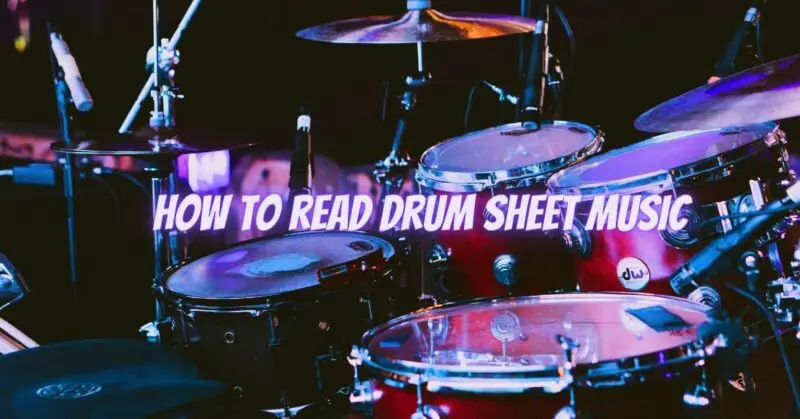Reading drum sheet music is a valuable skill that allows drummers to interpret musical compositions accurately and effectively. While it may seem complex at first, understanding the basics of drum notation can open up a world of possibilities for drummers. In this article, we will provide a comprehensive guide to help you navigate drum sheet music with confidence and enhance your drumming skills.
- Learn the Drum Notation Basics: Drum sheet music uses a set of symbols and markings to represent various drum sounds and techniques. Familiarize yourself with the following essential elements:
a. Staff: The staff consists of five horizontal lines and four spaces. Each line and space represents a different drum or cymbal.
b. Clef: Drum notation uses the percussion clef, which looks like a vertical line with two dots on either side.
c. Time Signature: The time signature indicates the number of beats in each measure and the note value that represents one beat.
d. Notes and Rests: Drum notes are represented by filled or unfilled circles placed on the staff, while rests indicate silent beats or measures.
e. Repeats and Endings: Repeats and endings are used to indicate repeated sections of music.
- Understand Drum Note Durations: Drum notes have different durations, represented by specific note values. Here are some common note durations in drum sheet music:
a. Whole Note: Represents four beats or a whole measure.
b. Half Note: Represents two beats.
c. Quarter Note: Represents one beat.
d. Eighth Note: Represents half a beat.
e. Sixteenth Note: Represents a quarter of a beat.
f. Rests: Indicate periods of silence and have durations corresponding to note values.
- Interpret Drum Sounds: Drum sheet music utilizes different symbols to represent specific drum sounds and techniques. Here are some commonly used symbols:
a. Bass Drum: Represented by a solid notehead placed on the bottom space of the staff.
b. Snare Drum: Represented by an X notehead placed on the middle line of the staff.
c. Hi-Hat: Represented by an “x” symbol on the top line of the staff for closed hi-hat and an open circle for open hi-hat.
d. Tom-Toms: Represented by noteheads placed on the spaces above or below the staff.
e. Cymbals: Represented by “x” symbols or an “o” symbol for crashes and rides.
- Practice Counting and Subdividing: To accurately read drum sheet music, it’s crucial to develop a sense of timing and understand how notes are subdivided within a measure. Practice counting beats aloud and subdividing them into smaller note values. For example, count four beats in a measure as “1 and 2 and 3 and 4 and” for quarter notes or “1 e and a 2 e and a” for sixteenth notes.
- Start with Simple Exercises: Begin your journey into drum sheet music by practicing simple exercises. Start with basic rhythms and gradually progress to more complex patterns. Focus on accuracy, timing, and interpretation. Break down the exercises into smaller sections and practice them at a slow tempo before gradually increasing the speed.
- Use Metronome and Play-Along Tracks: Playing along with a metronome or drum play-along tracks can greatly enhance your reading skills. Use a metronome to develop a solid sense of timing and maintain a steady tempo. Play-along tracks allow you to apply your reading skills in a musical context, helping you become more comfortable with different styles and song structures.
- Study Drum Transcriptions: Study drum transcriptions of your favorite songs or drum solos. Transcriptions provide a detailed breakdown of drum parts, allowing you to analyze patterns, fills, and variations. Compare the transcriptions to the original recordings, observing how the drum parts align with the music.
- Seek Guidance and Practice Regularly: Don’t hesitate to seek guidance from drum teachers or experienced drummers. They can provide valuable insights and help clarify any questions you may have about drum sheet music. Remember, regular practice is essential for improving your reading skills. Dedicate time to practice reading exercises and challenging yourself with new rhythms and patterns.
Conclusion: Reading drum sheet music is a valuable skill that expands your musical vocabulary and enables effective communication with other musicians. By understanding the basics of drum notation, familiarizing yourself with note durations and symbols, practicing counting and subdividing, and utilizing tools like metronomes and play-along tracks, you can develop the ability to read drum sheet music with confidence. Remember to start with simple exercises, study drum transcriptions, seek guidance when needed, and practice regularly to hone your reading skills. With time and dedication, you’ll unlock a world of musical possibilities and become a versatile drummer who can interpret and perform a wide range of music with accuracy and flair.


